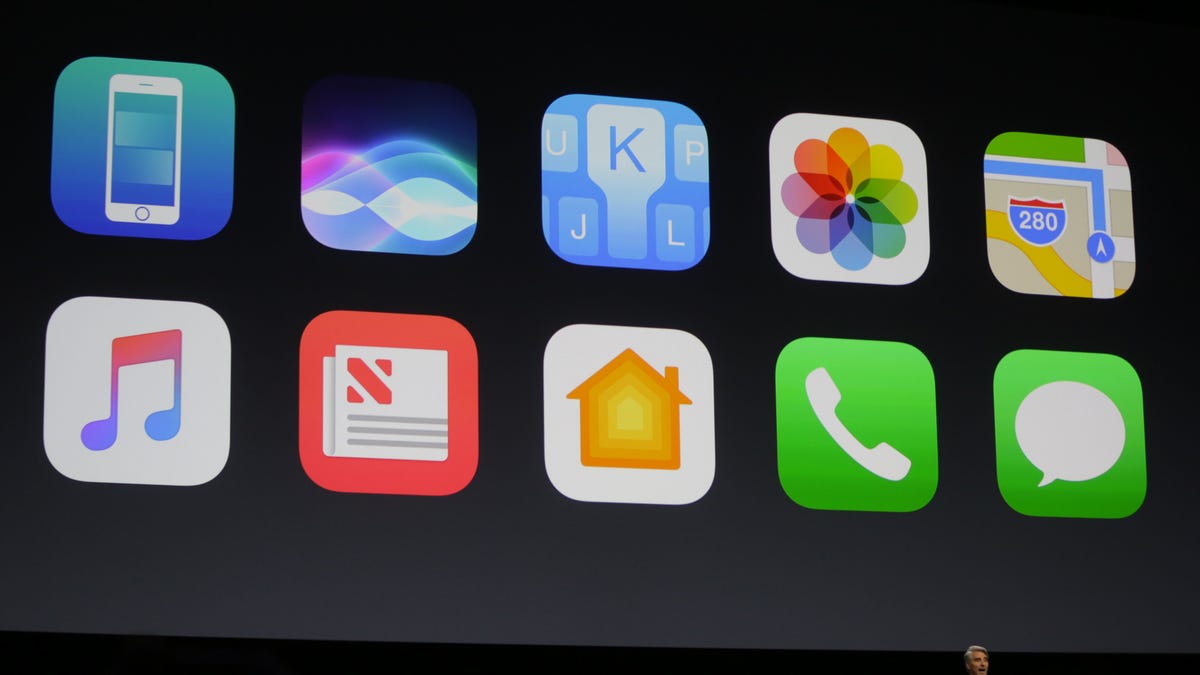Apple's iOS 10 plays catch up to Google
Now that the dust has settled on Apple's WWDC 2016 keynote, it's time to take a look at some familiar features.

After watching Apple's keynote at the Worldwide Developer Conference on Monday, you'd be forgiven for thinking you've seen some of these features before.
Here are some of the features in iOS 10 and Mac that take inspiration from Google -- and others.
Photos
With Apple's release of iOS 10, the Photos app will use machine learning and facial recognition to automatically group together photos of common faces or subjects without you needing to tag anything.
The Memories feature organizes photos into categories like trips, events and can even make videos with music that matches the mood.
Yet these were features that have already become commonplace with Google Photos when it launched in 2015. Search for "beach photos" and Google Photos aggregates all of the seaside images you've taken. Apply some more granularity like "beach photos taken in 2015" and information from a photo's metadata -- or EXIF data -- is used. This is all done in the cloud.
Apple's app differs in that it performs these tasks locally on the device. During the keynote, Apple mentioned a term called differential privacy. In effect, you're able to get the benefits of artificial intelligence and machine learning from crowdsourced learning, without sacrificing individual privacy. At this stage, it's still unclear exactly what data Apple is using in order to perform this computational analysis.
Apple is also ahead of the game in one area. It's Live Photos which are short bursts of animation that accompany regular photos.
Just last week, Google released an app called Motion Stills that stabilizes Live Photos to create a smooth animated GIF. Coming soon to iOS 10 is the ability to edit Live Photos including, you guessed it, digital stabilization. An app rendered obsolete in under a week? That just happened.
Messaging
Apple's Messages app is long overdue for a makeover and it's getting a big one with iOS 10.
A feature called bubble effects will let you choose the intensity of a response and have it appear as large or small text on screen. It also applies to emojis.
Sound familiar? See the Whisper Shout feature that was announced for Google's Allo messaging app just last month.
Messages will also now "emojify" words it thinks are appropriate and let you change it to an emoji when you see fit. This is already something that Google's Gboard keyboard for iOS does and plenty of third-party apps and keyboards on Android offer this functionality.
Facebook Messenger also deserves some credit here, with features like stickers, scribbling on images and third-party app integration.
Maps
With the release of iOS 10, Maps gets a new look and feel. On top of some interface spit and polish, expect to see additional functionality. Need a gas station or a restaurant on the way home? Apple Maps lets you add this on the route.
Google Maps added a similar feature in October 2015, allowing you to add pit stops along the way.
At WWDC 2016, Apple opened up Maps to third-party developers. So you can now order an Uber through Apple Maps or book a restaurant with OpenTable without leaving the app. Google Maps has offered both those integrations for a while now.
Voice assistant
Siri's coming to your MacBook.
It's a battle between artificial intelligence assistants with Siri now available on macOS.
Even though Apple didn't dedicate a significant portion of the WWDC 2016 keynote to Siri, there were still a few tidbits that gave us an indication of her improvements.
Siri may have been one of the first assistants on the block, but she's far from the most sophisticated in how she handles queries. That is set to change, at least on the Mac, with the keynote demo showing how users can now search for files with more awareness of context.
Want to set a reminder, find your files or search the web? Siri can do that. But then so can Cortana on Windows 10, and let's not even get started with Alexa on Amazon Echo.
Siri is also now open to developers and will integrate with third-party apps like WeChat, Slack or WhatsApp on iOS. You don't necessarily have to stick with the same syntax in how you speak either. Siri understands the difference between asking you to "send a WeChat message to Tina" and "Tell Tina via WeChat that I'm running 10 minutes late."
That's all well and good, except Google Now has been doing that for a while.
Music
Apple Music may have half the number of paid subscribers as Spotify so it does have some catching up to do. That said, Apple Music managed to snag that many paid users in just a year, whereas Spotify has been working toward it for a lot longer.
Spotify has a personalized discover weekly playlist that uses an algorithm to determine what you might like based on your listening taste. Apple Music will have a daily discovery playlist that does pretty much the same thing.
Music curation is a notoriously tricky area. An algorithm isn't necessarily as adept at picking out tracks you'll like compared to a set of human ears, so it will be interesting to see how Apple's version compares to the competition once the app gets updated.
To prove that all's fair in love and the music-streaming war, last month Spotify said that it would have original video content -- just like Apple Music announced earlier in the year.

